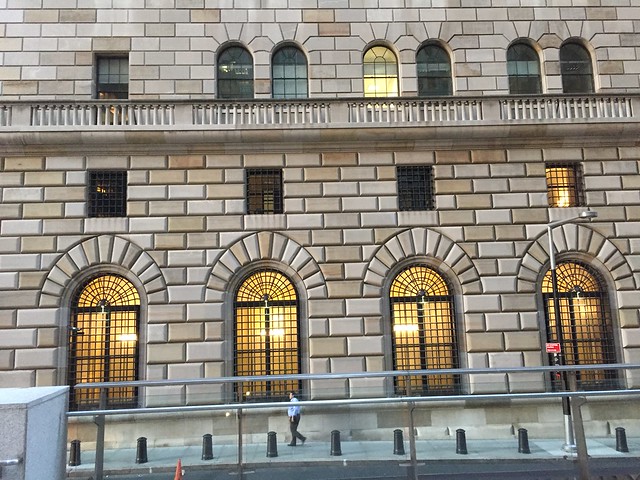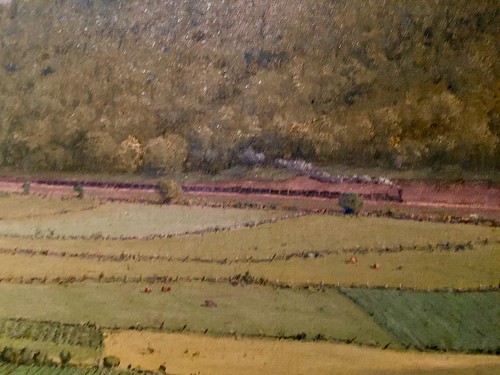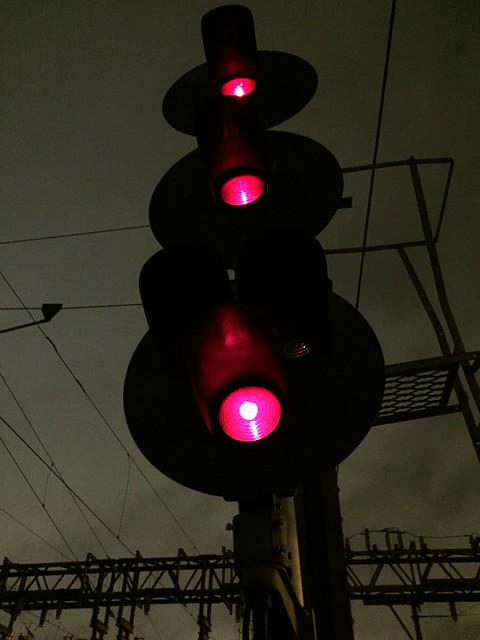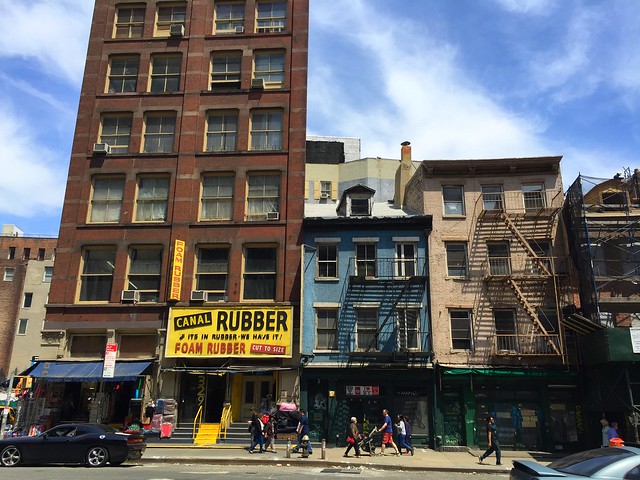
Posted in Art, Lower Manhattan |
Click on the above photo to see the full album.
Was up on the walkway of the Manhattan Bridge. The view is really incredible, especially of the rooftops of Chinatown, and the lower stretch of the East River. The walkway sways a little bit in the wind, and — there are subway tracks right beside it — it really shakes when a subway goes by. It’s much less touristy than the Brooklyn Bridge, and still reminds me a little bit of how the city was in the 80s and early 90s: lots of graffiti, neglected infrastructure, homeless people. I saw three street people getting high, and another lying flat on the walkway.
Posted in Common Law Urbanism, Spotlights |
Click on the above photo to see my full album.
Just some pictures from a recent visit to the Montclair Art Museum, which has a nice collection of George Inness paintings and personal effects. Inness was one of the best artists of 19th century America, specifically, the Northeast. A native of the Hudson Valley, he was sometimes associated with the Hudson River School, but he maintained a distinct approach that defies classification. His palette reminds me a little bit of Van Gogh’s, but his subject matter is much more realist. He spent a bunch of time in Montclair, taking the countryside around Newark as inspiration for a number of his paintings.
Posted in Art, Late Victorian, Spotlights |
Posted in Lower Manhattan, Spotlights |

Click on the above photo to see my full album!
The Federal Reserve Bank of New York is a truly incredible landmark. Completed in 1922 in the style of a Florentine palazzo, this stone fortress was built to house the most important regional branch of the Fed. Its design served the secondary purpose of communicating the solidity of American banking under the Federal Reserve System. The smooth-faced, rusticated masonry alternates between blocks of gray and tan, conveying something that cannot be moved, while hinting at the silver and gold that still backed up American currency at the time.
Tours of the interior are available, but tickets can be hard to come by. Once there, the Fed requires that you take part in a guided tour, which runs about an hour. Honey and I went one day last summer. Although such tours are not my favorite approach to exploration, I found this one incredibly interesting. The guide provided a short history of the Federal Reserve System; the construction and architecture of the building, itself; and a tour of the active gold vault, deep below Liberty Street. Unfortunately, the Fed has a very strict prohibition on photography within the building (under penalty of camera confiscation).
Posted in Lower Manhattan, Spotlights |
 A good decision was handed down by the New Jersey Supreme Court today on an important Mount Laurel controversy. In its unanimous ruling (responding to an interlocutory appeal from the Appellate Division), the Justices found that New Jersey municipalities must address the housing need that formed while the so-called Third Round numbers were in flux, between 1999 and 2015, in addition to the current need. This means the state’s towns and cities will be required to facilitate a larger number of affordable housing units.
A good decision was handed down by the New Jersey Supreme Court today on an important Mount Laurel controversy. In its unanimous ruling (responding to an interlocutory appeal from the Appellate Division), the Justices found that New Jersey municipalities must address the housing need that formed while the so-called Third Round numbers were in flux, between 1999 and 2015, in addition to the current need. This means the state’s towns and cities will be required to facilitate a larger number of affordable housing units.
Justice Jaynee LaVecchia, writing for the Court:
As to the fundamental disagreement — whether the gap period must be addressed — we waste no time in settling that issue. There is no fair reading of this Court’s prior decisions that supports disregarding the constitutional obligation to address pent-up affordable housing need for low- and moderate income households that formed during the years in which COAH was unable to promulgate valid Third Round rules.
Right on. The persistence of Mount Laurel cases highlights the virulent opposition from New Jersey municipalities to a 1970s finding that municipal zoning may not be used to exclude housing opportunities for low- and middle-income families in entire municipalities. For more than 40 years, certain towns have perennially fought to prevent this law from being carried out in a meaningful way. Their main complaint — though they rarely concede this in public — is the ‘fiscal impact’ of households whose children add to the public school rolls without contributing enough in property taxes to cover their costs. (Incidentally, the same stupid approach to school funding is one of the chief reasons New Jersey has become a paradise for strip mall development: more ratables, no kids.)
Credit goes to the New Jersey Supreme Court, which has maintained its jurisprudence on Mount Laurel for more than four decades. This has been done in the face of constant political pressure from those who would rather allow exclusionary, market-distorting zoning laws to go unchecked, allowing towns to become more exclusive, while pricing out more and more long-time residents.
Posted in Uncategorized |
Just some night photos from the Hoboken rail yards and surrounding blocks. (Click on the above photo to see my full album.)
As much as Hoboken has become a bland commuter city, a lot of the industrial-era infrastructure survives. The waterfronts in Hoboken, Jersey City, and Weehawken once served as a break-of-bulk point for all rail lines coming back to Port of New York from the American interior. In the 19th century, passengers and freight bound for New York City would leave the rails at these stations along the New Jersey waterfront to be ferried across the Hudson River to Manhattan. In the early 20th century, the Hudson Tubes made passenger service into Manhattan possible; and, later, the tunnels to Penn Station allowed the main lines to enter the city. Today, the PATH system still links the sites of three of the old New Jersey terminals: Hoboken (once the Delaware, Lackawanna & Western terminal), as well as Newport (once the Erie terminal) and Exchange Place (once the Pennsylvania Railroad terminal). Here is a map by James R. Irwin, showing the old setup:
Posted in Common Law Urbanism, Late Victorian, Rail & T.O.D., Spotlights |
Posted in Lower Manhattan, Spotlights |

One the most striking buildings in the New York Commons area, the Surrogate’s Courthouse was begun in 1899. In addition to housing the Manhattan probate court it is home to the municipal archives and is therefore sometimes called the Hall of Records.
The Surrogate’s Courthouse has some of the city’s most ornately detailed interior masonry, including heavy columns that support a mezzanine that encircles a soaring atrium. Building materials include variegated colored marble, like something out of classical antiquity. Natural lighting is sparse, and late-Victorian lamp fixtures do not fully compensate. It is enough to create a pervasive gloominess throughout the building. Together, these elements set the tone of its echoing corridors, which comprise a labyrinth of beautiful but eerie spaces — so fitting for a courthouse of this jurisdiction. This building is about death and dusty records, and its architecture reflects those cold facts through darkness and weight, but it also captures the somber and transcendent role of the law in making permanent the legacies of those who are gone. To be anodyne was not a priority in 1899.
Click on the above photo to see my full album.
Posted in Common Law Urbanism, Late Victorian, Lower Manhattan, Spotlights |
Posted in Common Law Urbanism, Lower Manhattan, Spotlights |






You must be logged in to post a comment.